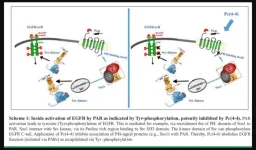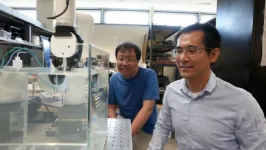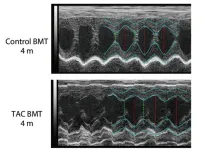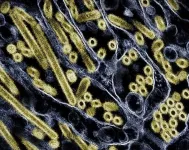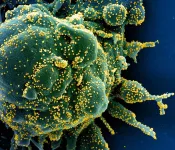(Press-News.org) Up to 80% of breast cancer deaths occur in patients with tumors that express estrogen receptor-alpha. Although these estrogen receptor-positive (ER+) breast cancers often initially respond to standard treatment that combines endocrine therapies with CDK4/6 inhibitors, drug resistance often develops leading to lethal metastatic disease that spreads from the breast and does not respond to available treatments.
Looking to identify new vulnerabilities in this type of cancer that could lead to improved therapies, researchers at Baylor College of Medicine and collaborating institutions focused on studying proteins produced by ER+ breast cancers that are resistant to the combination therapy. Specifically, they searched for enzymes called kinases, whose expression is typically altered in cancer. Their promising results are now published in Molecular Cancer Therapeutics, a journal of the American Association for Cancer Research.
“Kinases have proven to be effective therapeutic targets for cancer and there are many inhibitors of these enzymes that are already approved by the Food and Drug Administration for human use that could be tested for their potential therapeutic value in breast cancers,” said corresponding author Dr. Charles Foulds, assistant professor in the Lester and Sue Smith Breast Center and member of the Dan L Duncan Comprehensive Cancer Center at Baylor. “The challenge was to identify the kinase among hundreds of kinases in these treatment-resistant tumors that would help us turn the tide in the fight against this cancer.”
KIPA helps find the needle (select kinase) in a haystack (of hundreds of kinases)
The researchers had previously developed a laboratory method they called kinase inhibitor pull-down assay (KIPA) that significantly sped up the process of kinase identification among hundreds of potential candidates.
Working with 22 patient-derived xenografts (PDXs), human breast cancer tumors grown in immune-compromised mouse models, the team used KIPA to identify and then compare the kinases produced by tumors whose growth depended on the hormone estradiol, with the kinases produced by tumors whose growth was independent of that estrogen.
“The goal was to identify the difference between the estrogen-dependent group, which clinically represents cancers that respond to endocrine therapy (this therapy makes the estrogen the tumor needs to grow unavailable, therefore reducing cancer growth), versus tumors whose growth is independent of estrogen, which clinically, typically correlates with the group that does not respond to endocrine therapy,” said first author Dr. Anran Chen, a graduate student in the former Dr. Matthew Ellis lab and later a post-doctoral associate in the Foulds lab during this project. Chen is currently a senior scientist at Repare Therapeutics. “Our comprehensive analyses showed that the protein kinase, membrane-associated tyrosine/threonine one or PKMYT1, was our best candidate.”
Furthermore, patient clinical samples and breast cancer cell lines with high PKMYT1 mRNA levels, an indicator of PKMYT1 gene expression, were associated with resistance to both endocrine therapy and CDK4/6 inhibition. “These findings suggested that a high PKMYT1 level could be an indicator for treatment response in ER+ breast cancer tumors,” Chen said. “Because this kinase is involved in the regulation of cell division, we decided to investigate the effect a PKMYT1 inhibitor in clinical development would have on cancer growth.”
Therapeutic potential
Working with PDXs, organoids (mini tumors grown in the lab), cell lines and clinical samples, the researchers discovered that combining the PKMYT1 inhibitor lunresertib (also called RP-6306) with the chemotherapy drug gemcitabine selectively and synergistically reduced the viability of ER+ breast cancer cells that were resistant to endocrine therapy and the CDK4/6 inhibitor palbociclib and also lacked a functional tumor suppressor protein called p53. The absence of functional p53 disturbs cell cycle regulation in response to DNA damage, leading to poor clinical outcomes in ER+ breast cancer.
“We were excited to find that combining a PKMYT1 inhibitor with gemcitabine led to DNA damage and cell death in p53 dysfunctional cancer cells grown in the lab, and markedly reduced the size of PDX organoids grown in the lab and of tumors grown in immune-compromised mice, compared to treatment with either drug alone,” Foulds said.
“Our study shows that PKMYT1 is not only a potential marker for these tumors’ response to endocrine therapy and CDK4/6 inhibitor treatment, but also has clinical potential as a therapeutic target for treating drug resistant, mutant p53 ER+ breast cancer,” Chen said. “Our pre-clinical findings support further investigations to determine the value of this novel potential therapy to treat one of the most challenging human cancers.”
Additional co-authors of the paper are Beom-Jun Kim, Aparna Mitra, Craig T. Vollert, Jonathan T. Lei, Diana Fandino, Meenakshi Anurag, Matthew V. Holt, Xuxu Gou, Jacob B. Pilcher, Matthew P. Goetz, Donald W. Northfelt, Susan G. Hilsenbeck, C. Gary Marshall, Marc L. Hyer, Robert Papp, Shou-Yun Yin, Carmine De Angelis, Rachel Schiff, Suzanne A.W. Fuqua, Cynthia X. Ma and Matthew J. Ellis.
The authors are affiliated with one of the following institutions: Baylor College of Medicine, Repare Therapeutics, Adrienne Helis Malvin Medical Research Foundation, Mayo Clinic, University of Naples Federico II and Washington University School of Medicine, St. Louis.
This work was supported by grants from the Susan G. Komen Foundation (SAC190059, PG12220321, SAC130059, BCTR0707808), National Cancer Institute (P50CA186784, U54CA233223, and U01CA214125), a Susan G. Komen Foundation Scholarship, a McNair Scholarship supported by the McNair Medical Institute at The Robert and Janice McNair Foundation and a CPRIT Established Investigator Award (RR140033). This work was also supported by a SPORE Developmental Research Project grant (P50CA186784), an SRA with Repare Therapeutics, a charitable gift from Golfers Against Cancer, P50CA186784 grant, NIH grant R01CA072038 and Breast Cancer Research Foundation grant BCRF 22-055. This work was also partly supported by the Breast Cancer Research Foundation grants BCRF 20-145, 21-145, 22-145, the Cancer Prevention & Research Institute of Texas (CPRIT) grant RP140102, CPRIT training grant RP210027, NIH training grant T32CA203690 and grants U54CA224076 and U54CA224083. Further support was provided by a CPRIT Core Facility Support Grant and P30 Cancer Center Support Grant P30CA125123. The researchers gratefully acknowledge Pfizer for funding the NeoPalAna clinical trial.
###
END
PKMYT1, a potential ‘Achilles heel’ of treatment resistant ER+ breast cancers with the poorest prognosis
2024-05-24
ELSE PRESS RELEASES FROM THIS DATE:
PH-binding motifs as a platform for drug design: Lessons from protease-activated receptors (PARs)
2024-05-24
“We have identified binding motifs within the C-tails of PAR1,2&4, indispensable for cancer growth and development.”
BUFFALO, NY- May 24, 2024 – A new editorial paper was published in Oncoscience (Volume 11) on April 25, 2024, entitled, “PH-binding motifs as a platform for drug design: Lessons from protease-activated receptors; PARs.”
While targeted cancer therapy is greatly dependent on specific oncogenic pathways or conferred by genetic alterations, it remains yet challenging and somewhat disappointing. The high level of failure relies ...
Virginia Tech researcher creates new tool to move tiny bioparticles
2024-05-24
Undergoing surgery is seldom a pleasant experience, and it can sometimes be highly invasive. Surgical procedures have evolved steadily over the centuries, growing with the knowledge of anatomy and biology.
Innovative methods have also been bolstered with new tools, and a growth in the use of robotics since the 1980s has moved health care forward significantly. Assistant Professor Zhenhua Tian has pressed forward another step in the march of progress using robotics and noninvasive acoustics, and his team’s work has been published in Science Advances.
Robot-assisted surgery
Surgery using robots has been invasive since its invention because ...
On repeat: Biologists observe recurring evolutionary changes, over time, in stick insects
2024-05-24
LOGAN, UTAH, USA – A long-standing debate among evolutionary scientists goes something like this: Does evolution happen in a predictable pattern or does it depend on chance events and contingency? That is, if you could turn back the clock, as celebrated scientist Stephen Jay Gould (1941-2002) described in his famous metaphor, “Replaying the Tape of Life,” would life on Earth evolve, once again, as something similar to what we know now, or would it look very, very different?
“If you frame it as an either/or question, it’s too simplistic,” says Utah State University evolutionary biologist Zachariah Gompert. “The answer isn’t ‘completely ...
Understanding a broken heart
2024-05-24
The stress of heart failure is remembered by the body and appears to lead to recurrent failure, along with other related health issues, according to new research. Researchers have found that heart failure leaves a “stress memory” in the form of changes to the DNA modification of hematopoietic stem cells, which are involved in the production of blood and immune cells called macrophages. These immune cells play an important role in protecting heart health. However, a key signaling pathway (a chain of molecules which ...
Genetic cause of rare childhood immune disorders discovered
2024-05-24
Scientists have pinpointed genetic changes that can leave children born with little to no immune defence against infection.
In a new study of 11 affected individuals, researchers from Newcastle University, the Wellcome Sanger Institute, the Great North Children’s Hospital, and their collaborators were able to link mutations in the NUDCD3 gene to Severe Combined Immunodeficiency and Omenn syndrome1 – rare and life-threatening immunodeficiency disorders. These mutations prevented the normal development of diverse immune cells needed to combat different pathogens2.
The findings, published today (24 May) in Science Immunology, ...
With wobbling stars, astronomers gauge mass of 126 exoplanets and find 15 new ones
2024-05-24
LAWRENCE — Using data from the Transiting Exoplanet Survey Satellite and W.M. Keck Observatory on Mauna Kea in Hawaii, an astronomer at the University of Kansas led a study appearing today revealing 15 new exoplanets — planets beyond our solar system — along with the mass of 126 other exoplanets. The findings give astronomers new understanding of the makeup of exoplanets and their star systems generally.
The study cataloging the exoplanets — comprising severe and exceptional environments, some of which hold promise to support life — was conducted under auspices of the TESS-Keck Survey and appears ...
High H5N1 influenza levels found in mice given raw milk from infected dairy cows
2024-05-24
WHAT:
Mice administered raw milk samples from dairy cows infected with H5N1 influenza experienced high virus levels in their respiratory organs and lower virus levels in other vital organs, according to findings published in the New England Journal of Medicine. The results suggest that consumption of raw milk by animals poses a risk for H5N1 infection and raises questions about its potential risk in humans.
Since 2003, H5N1 influenza viruses have circulated in 23 countries, primarily affecting wild birds and poultry with about 900 human cases, primarily among people who have had close contact with infected birds. In ...
Study finds discreet shipping used to sell e-cigarettes to minors
2024-05-24
Researchers at the U of A found self-identified small business owners on TikTok are circumventing a number of local, state and federal laws that restrict the individual sale of tobacco products. Specifically, the researchers found that 45% of the videos highlighted the fact that they did not require identification to verify the purchaser’s age.
“Many states have laws that govern procedures necessary to sell e-cigarettes,” explained lead researcher Page Dobbs, an associate professor of public health in the Department of Health, Human Performance and Recreation ...
African scientists call for equitable research partnerships to advance microbiome research
2024-05-24
Leading African scientists have issued a compelling call for more equitable research partnerships in a new paper published in Nature Medicine. The paper underscores the critical need for fair and collaborative research efforts to explore the unique and diverse microbiomes found in African populations and environments. Historically, these microbiomes have been underrepresented in global studies.
Over the past two decades, our understanding of the role played by the microbiome in different ecosystems has significantly expanded. For ...
How COVID-19 'breakthrough' infections alter your immune cells
2024-05-24
LA JOLLA, CA—New research from scientists at La Jolla Institute for Immunology (LJI) suggests people who received COVID-19 vaccines and then experienced "breakthrough" infections are especially well armed against future SARS-CoV-2 infections.
By analyzing blood samples from study volunteers, the LJI researchers discovered that people who experienced symptomatic breakthrough infections develop T cells that are better at recognizing and targeting SARS-CoV-2, including the Omicron and Delta variants. The researchers describe this increased protection as an "immunity wall."
"The virus evolves, but, importantly, so does the immune system. T cells ...
